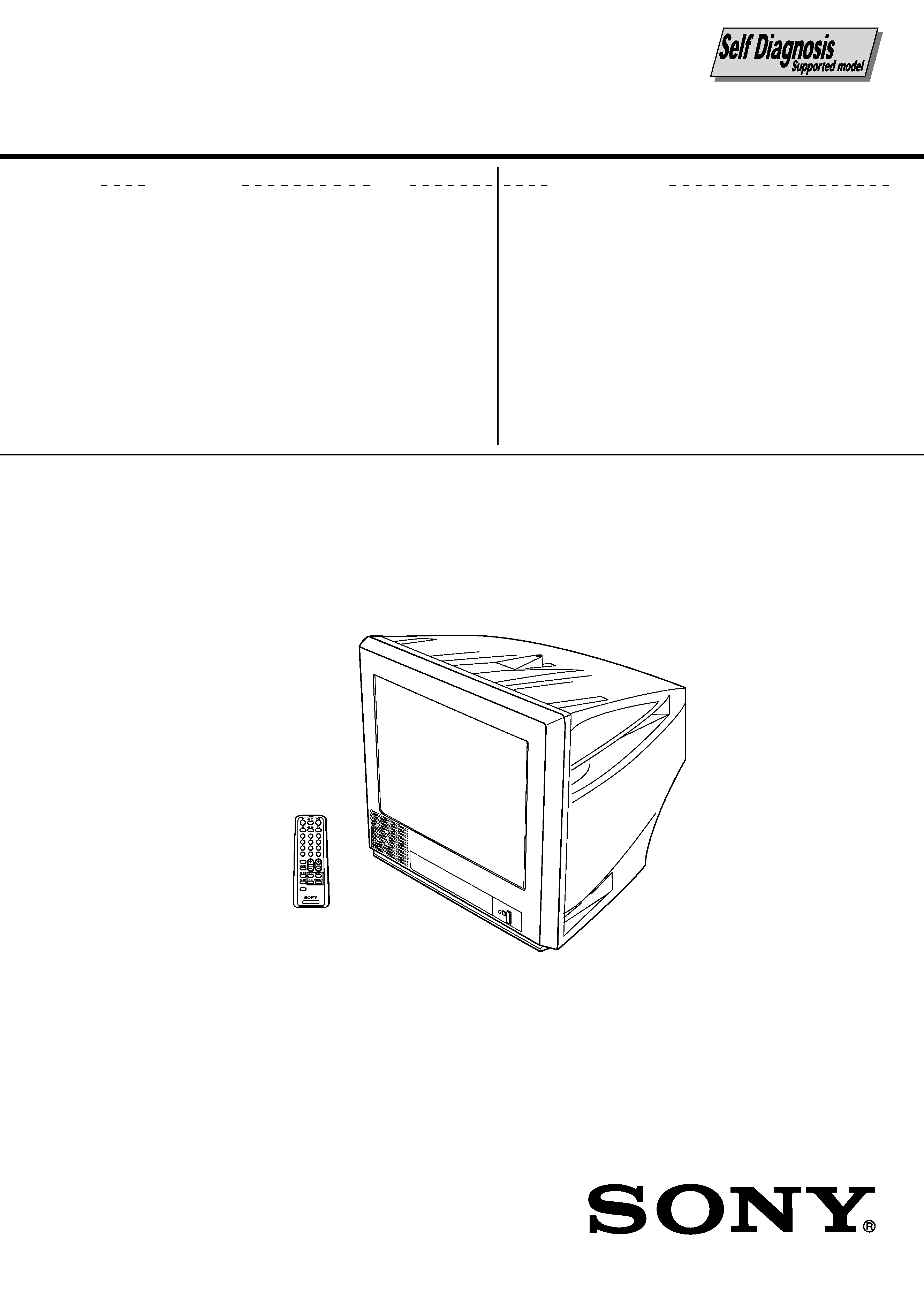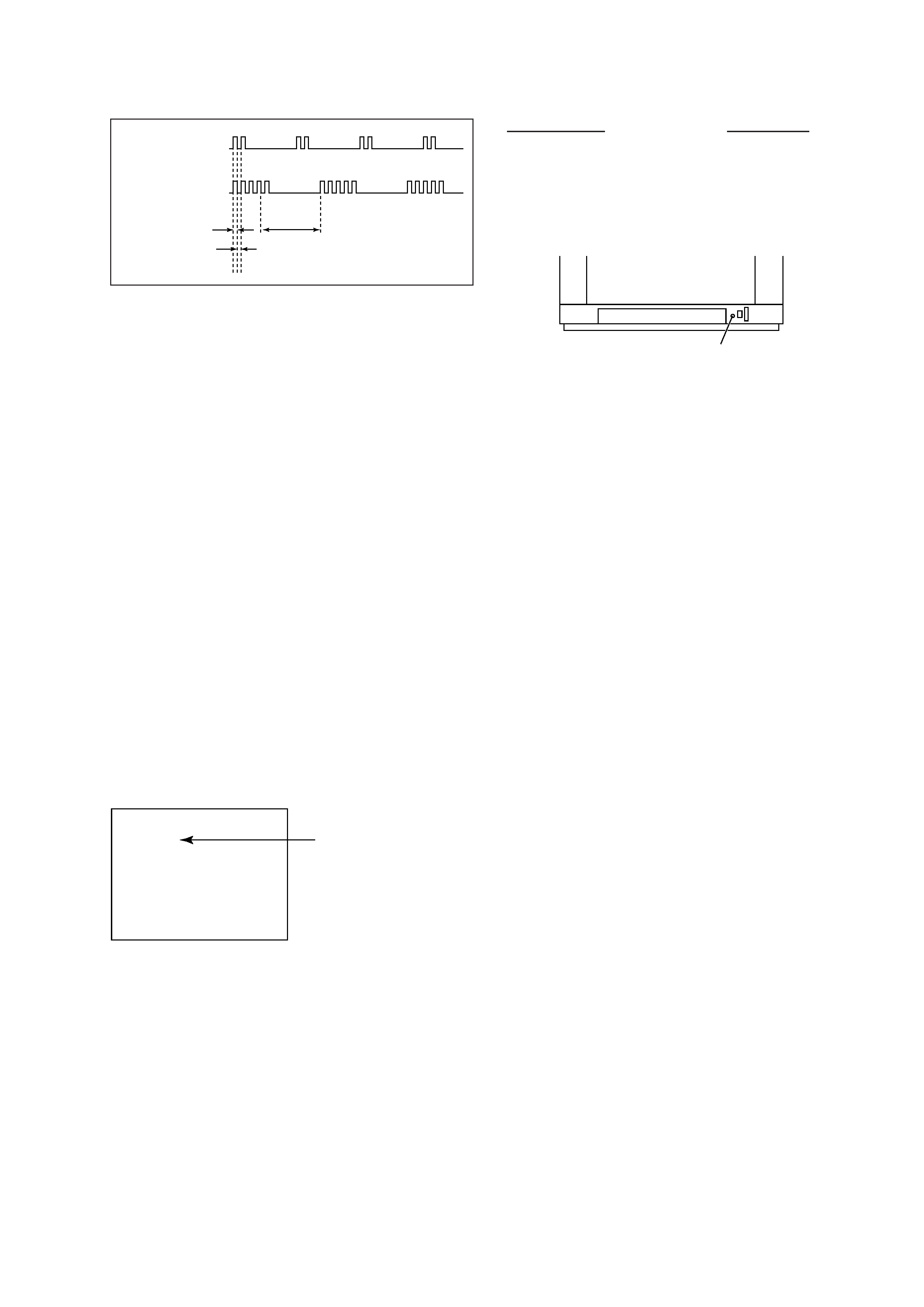
MODEL
COMMANDER DEST. CHASSIS NO.
CHASSIS
TRINITR ON ® COLOR TV
SERVICE MANUAL
BG2T
MODEL
COMMANDER DEST.
CHASSIS NO.
KV-PG14P10 RM-952
Oceania
SCC-U62B-A
KV-PG14P10/G RM-952
Australia
SCC-U72A-A
KV-PG14P10/L RM-952
Oceania
SCC-U62C-A
KV-PG14P40/L RM-952
GE
SCC-U69B-A
KV-PG14P40/N RM-952
GE
SCC-U69D-A
TV
1
2
3
4
6
7
8
9
÷
0
5
JUMP
SOUND
MODE
FAVORITE
PROGR
Á

2
KV-PG14P10/PG14P10/G/PG14P10/L
KV-PG14P40/L/PG14P40/N
RM-952
SPECIFICATIONS
SAFETY-RELATED COMPONENT WARNING!!
COMPONENTS IDENTIFIED BY SHADING AND MARK
! ON
THE SCHEMATIC DIAGRAMS, EXPLODED VIEWS AND IN
THE PARTS LIST ARE CRITICAL TO SAFE OPERATION.
REPLACE THESE COMPONENTS WITH SONY PARTS
WHOSE PART NUMBERS APPEAR AS SHOWN IN THIS
MANUAL OR IN SUPPLEMENTS PUBLISHED BY SONY.
CAUTION
SHORT CIRCUIT THE ANODE OF THE PICTURE TUBE AND
THE ANODE CAP TO THE METAL CHASSIS, CRT SHIELD,
OR CARBON PAINTED ON THE CRT, AFTER REMOVING THE
ANODE.
Power requirements
110-240 V AC, 50/60 Hz
KV-PG14P40
220-240V AC, 50/60 Hz
KV-PG14P10
Power consumption (W)
Indicated on the rear of the TV
Television system
B/G
Color system
PAL, PAL 60, NTSC3.58 (AV IN), NTSC4.43
Channel coverage
VHF: E2 to E12 / UHF: E21 to E69/
CATV: S01 to S03, S1 to S41
VHF: 0 to 12, 5A,19A / UHF: 28 to 69
Australia only
CATV: S01 to S03, S1 to S41
VHF: 1 to 11 / UHF: 21 to 69
New Zealand only
CATV: S01 to S03, S1 to S41
(Antenna)
75-ohm external terminal
Audio output (Speaker)
3W
Number of terminal
DVideo
Input: 2* Output: 1
Phone jacks; 1 Vp-p, 75 ohms
*One input line available
Audio
Input: 2* Output: 1
Phone jacks; 500 mVrms
*One input line available
(Earphone)
Output: 1
Monaural minijack
Picture tube
14 in
Tube size (cm)
37
Measured diagonally
Screen size (cm)
34
Measured diagonally
Dimension (w/h/d,mm)
375 x 346 x 411
Mass (kg)
12
Design and specifications are subject to change without notice.
Note

KV-PG14P10/PG14P10/G/PG14P10/L
KV-PG14P40/L/PG14P40/N
RM-952
3
TABLE OF CONTENTS
SELF DIAGNOSTIC FUNCTION ................................... 4
1. GENERAL ................................................................. 7
2. DISASSEMBLY
2-1. Rear Cover Removal ............................................... 11
2-2. Speaker Removal .................................................... 11
2-3. Chassis Assy Removal ............................................ 11
2-4. F Board Removal .................................................... 11
2-5. Service Position ...................................................... 11
2-6. Terminal Bracket Removal ..................................... 11
2-7. Replacement Of Parts ............................................. 12
2-7-1. Replacement Of Light Guide ....................... 12
2-7-2. Replacement Of Power Button .................... 12
2-8. Picture Tube Removal ............................................. 12
3. SET-UP ADJUSTMENTS
3-1. Beam Landing ......................................................... 14
3-2. Convergence ............................................................ 15
3-3. Focus Adjustment .................................................... 17
3-4. G2 (SCREEN) and white balance adjustments ...... 17
4. CIRCUIT ADJUSTMENTS
4-1. Adjustment With Commander ................................ 18
4-2. Adjustment Method ................................................ 18
4-3. Picture Quality Adjustment .................................... 23
4-4. Deflection Adjustment ............................................ 23
4-5. A Board Adjustment After IC003 (MEMORY)
Replacement ............................................................ 23
4-6. Picture Distortion Adjustment ................................ 24
Section
Title
Page
Section
Title
Page
5. DIAGRAMS
5-1. Block Diagram ........................................................ 25
5-2. Circuit Boards Location .......................................... 27
5-3. Schematic Diagram ................................................. 28
(1) Schematic Diagram of A Board ........................ 29
(2) Schematic Diagrams of C and F Boards .......... 31
5-4. Voltage Measurement ............................................. 34
5-5. Waveforms .............................................................. 36
5-6. Printed Wiring Boards and Parts Location ............. 37
5-7. Semiconductors ....................................................... 40
6. EXPLODED VIEWS
6-1. Picture tube and Chassis ......................................... 42
7. ELECTRICAL PARTS LIST .................................... 43

4
KV-PG14P10/PG14P10/G/PG14P10/L
KV-PG14P40/L/PG14P40/N
RM-952
The units in this manual contain a self-diagnostic function. If an error occurs, the STANDBY/TIMER lamp will automati-
cally begin to flash.
The number of times the lamp flashes translates to a probable source of the problem. A definition of the STANDBY/
TIMER lamp flash indicators is listed in the instruction manual for the user's knowledge and reference. If an error
symptom cannot be reproduced, the remote commander can be used to review the failure occurrence data stored in
memory to reveal past problems and how often these problems occur.
1. DIAGNOSTIC TEST INDICATORS
When an errors occurs, the STANDBY/TIMER lamp will flash a set number of times to indicate the possible cause of the
problem. If there is more than one error, the lamp will identify the first of the problem areas.
Result for all of the following diagnostic items are displayed on screen. No error has occured if the screen displays a "0".
Diagnostic
Item
Description
· Power does not
turn on
· +B overcurrent
(OCP)
· Horizontal
deflection
overdrive
· White balance
failure (no
PICTURE)
· Vertical deflection
stopped
· Micro reset
Detected
Symptoms
· Power does not come on.
· No power is supplied to
the TV.
· AC power supply is faulty.
· Power does not come on.
· Load on power line is
shorted.
· Has entered standby state
after horizontal raster.
· Power line is shorted or
power supply is stopped.
· Vertical deflection pulse
is stopped
· Power is shut down
shortly, after this return
back to normal.
· Detect Micro latch up.
Note 1: If a + B overcurrent is detected, stoppage of the vertical deflection is detected simultaneously.
The symptom that is diagnosed first by the microcontroller is displayed on the screen.
Note 2: Refer to screen (G2) Adjustment in section 3-4 of this manual.
SELF DIAGNOSTIC FUNCTION
No. of times
STANDBY/TIMER
lamp flashes
Does not light
2 times
4 times
--
Self-diagnostic
display/Diagnostic
result
--
002:000 or
002:001~255
004:000 or
004:001~225
101:00 or
101:001~225
Probable
Cause
Location
· Power cord is not
plugged in.
· Fuse is burned out
F4601 (F)
· H.OUT Q801 is shorted.
(A board)
· -13V is not supplied.
(A board)
· IC 551 faulty (A board)
· Discharge CRT
(C Board)
· Static discharge
· External noise

5
KV-PG14P10/PG14P10/G/PG14P10/L
KV-PG14P40/L/PG14P40/N
RM-952
2. DISPLAY OF STANDBY/TIMER LIGHT FLASH COUNT
3. STOPPING THE STANDBY/TIMER FLASH
Turn off the power switch on the TV main unit or unplug the power cord from the outlet to stop the STANDBY/TIMER
lamp from flashing.
4. SELF-DIAGNOSTIC SCREEN DISPLAY
For errors with symptoms such as "power sometimes shuts off" or "screen sometimes goes out" that cannot be con-
firmed, it is possible to bring up past occurances of failure for confirmation on the screen:
[To Bring Up Screen Test]
In standby mode, press buttons on the remote commander sequentially in rapid succession as shown below:
[Screen display] / channel [5] / Sound volume [-] / Power ON
Note that this differs from entering the service mode (mode volume [+]).
Self-Diagnosis screen display
STANDBY/SLEEP lamp
Lamp ON 0.3 sec.
Lamp OFF 3 sec.
Lamp OFF 0.3 sec.
2 times
4 times
Diagnostic Item
Flash Count*
+B overcurrent/overvoltage
2 times
Vertical deflection stopped
4 times
* One flash count is not used for self-diagnostic.
002 : 000
004 : 000
Numeral "0" means that no fault has been detected.
101 : 000
SELF DIAGNOSTIC
